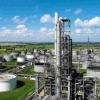Hello All,
I am very new to process engineering (I have never done it) and I have been presented a problem that I need help on. I work for a small manufacturing firm that designs and builds surface production equipment. My background is in well testing and artificial lift systems just in case there are any questions to that regard.
I am to size a TEG dehydrator unit (column, reboiler, glycol circulation pump, glycol and flash separator)
I have been given the following information:
Gas Volume Rate to be Processed: Min. 300 Mscf/d, Max 500 Mscf/d
Operating Pressure: Min. 300 psi max. 395 psi
Requested Design Pressure: 500 psi
Operating Temperature: Lowest (40 F) Highest (95 F)
No Inlet Moisture Content Given
Required Outlet Moisture Content: 7 lb H20/MMscf
Pipeline Size: 2 in
I have been reading throughout the forums, but a lot of the info on process design is greek to me.
1. Is there a method to finding glycol to water circulation rate? I have found that the usual rate is around 2 to 3 gal TEG/lb water
2. How do I find or calculate the lean glycol concentration needed?
3. Our reboilers are rated at a temperature of around 250 F. I have no idea what method they used to calculate the temperature. I am assuming that it is through field experience the owners have.
4. How is heat flux calculated and what is its purpose?
5. Tray design methods seem very difficult. I have found charts to help decide how many trays (Campbell's Processing books) and several equations based off of theoretical trays.
There is a lot of information and I need to find out what I need to create an accurate spreadsheet to design TEG dehydrator units. Any advice and help would be appreciated.
Regards,
Sam
|
|
Teg Dehydrator Unit Design
Started by SamPetro, Jul 28 2010 07:57 AM
5 replies to this topic
Share this topic:
#1

Posted 28 July 2010 - 07:57 AM
#2

Posted 28 July 2010 - 09:05 AM
SamPetro,
Have a look at the following post where I have provided a link for TEG dehydrator design guidelines and spreadsheet calculations. For preliminary sizing this should suffice:
http://www.cheresour...__1
Most actual designs are done using a simulation software such as HYSYS or ProMax but then these are expensive softwares and require a quite a bit of hands-on experience for operating these softwares. Manufacturers such as NATCO & Q.B. Johnson will provide he design as well as the process operating guarantees if the TEG dehydration system is bought from them.
Hope this helps.
Regards,
Ankur.
Have a look at the following post where I have provided a link for TEG dehydrator design guidelines and spreadsheet calculations. For preliminary sizing this should suffice:
http://www.cheresour...__1
Most actual designs are done using a simulation software such as HYSYS or ProMax but then these are expensive softwares and require a quite a bit of hands-on experience for operating these softwares. Manufacturers such as NATCO & Q.B. Johnson will provide he design as well as the process operating guarantees if the TEG dehydration system is bought from them.
Hope this helps.
Regards,
Ankur.
#3

Posted 29 July 2010 - 12:57 AM
SamPetro,
I am sure link provided by Ankur has helped you a lot.
Below is point wise explanation of your queries.
1. It’s a tradeoff between TEG glycol to water circulation rate and number of stages. More the number of stages, smaller the TEG glycol to water circulation rate. You can find a graph relating glycol to water circulation rate and number of stages in any gas processing book.
2. Glycol concentration depends upon the regeneration method-with or without the stripping gas. Without stripping gas, you can achieve only 98.9 mass% TEG. However, with stripping gas, you will be able to get more than 99.7 mass% depending upon the stripping gas rate.
3.I don’t know where you saw 250°C reboiler temperature. TEG reboiler is operated at maximum of 400°F (204.44°C) to avoid TEG degradation.
4. Heat flux is heat transferred per unit surface area. Large heat flux means that more heat is transferred per unit surface area. Large heat flux yields large surface temperatures and large surface temperatures may cause thermal degradation of TEG. With hot oil and steam heating systems, risk of thermal degradation is low since the heat media is usually not operated at high temperature. However, in fired-reboiler operation, the temperature of TEG on the tube’s surface can easily exceed the degradation temperature. For TEG reboiler, heat flux is limited to 10,000 Btu/hr.ft2. Another purpose of limiting heat flux is to keep the boiling fluid within the nucleate boiling region away from the critical heat flux. Exceeding the critical heat flux will cause gas binding. You may consult any heat transfer book to study fundamentals of pool boiling.
5. Tray design is a specialized job and we always consult a specialist tray vendor for tray deign. These vendors can also provide you with their free proprietary softwares which are excellent for tray deign. For preliminary tray design, I have found the easiest methods in GPSA, Chapter 19, Fractionation and Absorption.
Thanks
I am sure link provided by Ankur has helped you a lot.
Below is point wise explanation of your queries.
1. It’s a tradeoff between TEG glycol to water circulation rate and number of stages. More the number of stages, smaller the TEG glycol to water circulation rate. You can find a graph relating glycol to water circulation rate and number of stages in any gas processing book.
2. Glycol concentration depends upon the regeneration method-with or without the stripping gas. Without stripping gas, you can achieve only 98.9 mass% TEG. However, with stripping gas, you will be able to get more than 99.7 mass% depending upon the stripping gas rate.
3.I don’t know where you saw 250°C reboiler temperature. TEG reboiler is operated at maximum of 400°F (204.44°C) to avoid TEG degradation.
4. Heat flux is heat transferred per unit surface area. Large heat flux means that more heat is transferred per unit surface area. Large heat flux yields large surface temperatures and large surface temperatures may cause thermal degradation of TEG. With hot oil and steam heating systems, risk of thermal degradation is low since the heat media is usually not operated at high temperature. However, in fired-reboiler operation, the temperature of TEG on the tube’s surface can easily exceed the degradation temperature. For TEG reboiler, heat flux is limited to 10,000 Btu/hr.ft2. Another purpose of limiting heat flux is to keep the boiling fluid within the nucleate boiling region away from the critical heat flux. Exceeding the critical heat flux will cause gas binding. You may consult any heat transfer book to study fundamentals of pool boiling.
5. Tray design is a specialized job and we always consult a specialist tray vendor for tray deign. These vendors can also provide you with their free proprietary softwares which are excellent for tray deign. For preliminary tray design, I have found the easiest methods in GPSA, Chapter 19, Fractionation and Absorption.
Thanks
Edited by P.Engr, 29 July 2010 - 01:01 AM.
#4

Posted 29 July 2010 - 10:23 AM
Sam:
Your typical questions reveal a deficiency in process engineering design. You have a lot of work, study, and experience levels to go through before you can handle a TEG unit – as simple as it might seem. Please take this comment as an attempt at helping you and not as pure criticism. What Ankur has stated is very true and meant to guide you as to what is practically done in the industrial world to acquire a TEG unit. The design of such equipment is very specialized and experienced, recognized designers are selected based on their ability not only to design and build such a unit, but to also guarantee the characteristics and results of its operation. That means financial liability and no design group will take on such an endeavor without ensuring that its members are fully versed and experienced in the specific field of natural gas dehydration.
There are many basic and simple facts that you need to acquire and be aware of in TEG dehydration. Some of these are:
P.Engr is correct; the TEG process is made up of many tradeoffs. These have to be recognized and applied on a project-to-project basis. There are no simple rules, equations, or rules of thumb to apply. Experience and knowledge are the fundamental building blocks. For example, I personally would not employ Hysis as a simulation tool to design such a unit. I have found it has inherent errors in this application.
You must identify the design moisture content of the product gas you are seeking to produce. This fixes the Lean TEG purity (& the stripping gas requirement), the circulation rate, and the temperatures involved in both gas and TEG.
You must know and dominate the basics of Unit Operations before attempting to understand a TEG unit. For example, P.Engr states “Another purpose of limiting heat flux is to keep the boiling fluid within the nucleate boiling region away from the critical heat flux”. This is an erroneous statement. There simply is NO REBOILING OR BOILING taking place in the “reboiler”. The term “reboiler” is a misnomer as employed in the TEG process. TEG does not boil in the reboiler since its atmospheric boiling point is 550 oF; the TEG water content is removed in accordance with its vapor pressure as a result of heating the TEG to 400 oF (max.). therefore, there is no nucleate boiling or gas binding taking place. The concern is for TEG degradation and, as such, some major energy companies use as low as 6,000 btu/ft2-oF as a design heat flux. Definitely, heating a reboiler with hot oil is to be preferred because of the even, steady, low heat concentration. However, this involves a tradeoff in capital monies (as usual).
Since most operators do not operate the reboiler at a temperature much above 400 oF because of fear of TEG decomposition, it is apparent that about the best we can do at atmospheric pressure without stripping gas is to obtain glycol with about 2 percent water – 98% TEG purity. If you take a look at the TEG + Water Temperature vs. Composition, you will see that the curve is very steep – it tends to be exponential at about 95% TEG (290 oF) and quickly increases after that.
The equilibrium water dewpoint of natural gas exiting a TEG contactor at 90 oF and using 98% TEG is approximately 13 oF – and this is subject to a contingency being added. You normally would want an equilibrium dewpoint of around -20 oF or lower. Therefore, you would require a TEG concentration of 99.5% or greater – something you can’t achieve by simply heating the TEG higher. This explains why the only other practical remedy employed to increase the Lean TEG to a purity of 99.5% or greater is to use stripping gas on the Lean TEG exiting the reboiler.
I hope this experience helps you out.
#5

Posted 30 July 2010 - 02:36 AM
Dear Art,
I think there is some miscommunication. If you read my earlier post carefully, i have stated:
"Another purpose of limiting heat flux is to keep the boiling fluid within the nucleate boiling region away from the critical heat flux."
I have not stated that TEG is boiling. Actually, I was trying to give a general concept about heat flux and about why to control heat flux? I know that TEG is not at its boiling point. The key for separation of H2O from TEG is the difference in their boiling points. How can we separate water from TEG if TEG is at its boiling point?
Sorry for the miscommunication.
I think there is some miscommunication. If you read my earlier post carefully, i have stated:
"Another purpose of limiting heat flux is to keep the boiling fluid within the nucleate boiling region away from the critical heat flux."
I have not stated that TEG is boiling. Actually, I was trying to give a general concept about heat flux and about why to control heat flux? I know that TEG is not at its boiling point. The key for separation of H2O from TEG is the difference in their boiling points. How can we separate water from TEG if TEG is at its boiling point?
Sorry for the miscommunication.
#6

Posted 03 September 2010 - 12:21 PM
All,
I want to thank you for your responses. I approached the owners of the company I work for and said I was not qualified to do the designs they wanted. They are in the process of hiring an experienced processing engineer.
Art, I have read many of your articles and have found them to be beneficial. I agree that I lack the necessary experience and study to design TEG units. I have committed to learn more on process and chemical engineering.
I'll continue to study and gain experience in the field of process engineering.
Regards,
Sam
I want to thank you for your responses. I approached the owners of the company I work for and said I was not qualified to do the designs they wanted. They are in the process of hiring an experienced processing engineer.
Art, I have read many of your articles and have found them to be beneficial. I agree that I lack the necessary experience and study to design TEG units. I have committed to learn more on process and chemical engineering.
I'll continue to study and gain experience in the field of process engineering.
Regards,
Sam
Similar Topics
Wet Scrubber Design For Low Flow Rate Of GasStarted by Guest_SIVAMOORTHY_* , 17 Apr 2018 |
|

|
||
Rupture Disk Tail/lateral Piping Design BasisStarted by Guest_Karthikram_* , 19 Aug 2025 |
|

|
||
Design Of Direct Contact After Cooler (Dcac) For Air Separation UnitStarted by Guest_Paulogeorge_* , 29 Jul 2025 |
|

|
||
Design Capacity Of Hydrogen Pullet During Hydroprocessing Units UpsetStarted by Guest_Divid Kelin_* , 18 Jun 2025 |
|

|
||
Hot Oil Loop / Heating Medium DesignStarted by Guest_Lyne_* , 30 Mar 2024 |
|

|

 FB
FB








